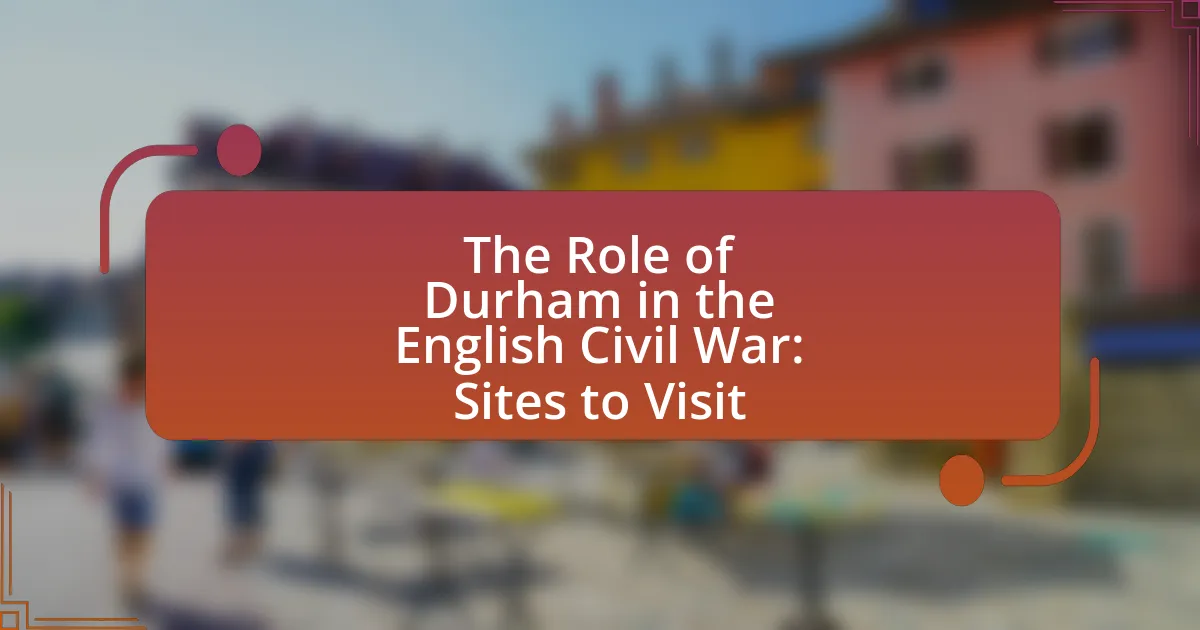Accessible attractions in County Durham are designed to accommodate visitors with diverse needs, ensuring inclusivity for all. Key sites such as Durham Cathedral, the Bowes Museum, and the Beamish Museum provide essential facilities like wheelchair access, sensory-friendly experiences, and trained staff to assist individuals with disabilities. The article outlines how these attractions meet accessibility standards, the importance of inclusivity for tourism, and the economic benefits of accessible tourism. Additionally, it discusses the challenges faced in enhancing accessibility and offers insights into best practices and community involvement to improve visitor experiences.

What are Accessible Attractions in County Durham?
Accessible attractions in County Durham include the Durham Cathedral, which offers wheelchair access and guided tours for visitors with mobility challenges. Additionally, the Bowes Museum provides accessible facilities and exhibitions designed for all visitors, including those with disabilities. The Beamish Museum features accessible pathways and transport options, ensuring that everyone can enjoy its historical exhibits. These attractions are designed to accommodate diverse needs, making County Durham a welcoming destination for all.
How do these attractions cater to visitors with disabilities?
Attractions in County Durham cater to visitors with disabilities by providing accessible facilities and services. These include wheelchair ramps, accessible restrooms, and designated parking spaces to ensure ease of access. Many attractions also offer guided tours tailored for individuals with mobility challenges, as well as sensory-friendly experiences for those with sensory sensitivities. Additionally, staff are trained to assist visitors with disabilities, enhancing their overall experience. For example, the Bowes Museum features a comprehensive accessibility plan that includes audio guides and tactile exhibits, demonstrating a commitment to inclusivity.
What specific features make these attractions accessible?
Accessible attractions in County Durham feature ramps, wide pathways, and designated parking spaces to accommodate visitors with mobility challenges. These features ensure that individuals using wheelchairs or other mobility aids can navigate the attractions easily. Additionally, many sites offer accessible restrooms and sensory-friendly environments, enhancing the experience for visitors with various needs. For instance, the availability of audio guides and tactile exhibits further supports inclusivity, allowing all visitors to engage fully with the attractions.
How do accessibility standards influence attraction design?
Accessibility standards significantly influence attraction design by ensuring that facilities are usable by individuals with diverse abilities. These standards, such as the Americans with Disabilities Act (ADA) in the United States, mandate features like ramps, accessible restrooms, and clear signage, which enhance the overall experience for all visitors. Compliance with these standards not only promotes inclusivity but also expands the potential visitor base, as attractions that are accessible can accommodate people with mobility challenges, sensory impairments, and other disabilities. For instance, a study by the National Park Service found that accessible design features can increase visitor satisfaction and engagement, demonstrating the positive impact of adhering to accessibility standards in attraction design.
Why is accessibility important for tourism in County Durham?
Accessibility is important for tourism in County Durham because it ensures that all individuals, regardless of physical ability, can enjoy the region’s attractions and experiences. By providing accessible facilities and services, County Durham can attract a broader audience, including people with disabilities, families with young children, and older adults. This inclusivity not only enhances the visitor experience but also contributes to the local economy; research indicates that accessible tourism can increase revenue by up to 25% in destinations that prioritize inclusivity. Therefore, improving accessibility is essential for maximizing tourism potential and fostering a welcoming environment for all visitors in County Durham.
What impact does accessibility have on visitor experience?
Accessibility significantly enhances visitor experience by ensuring that all individuals, regardless of ability, can fully engage with attractions. When attractions are designed with accessibility in mind, they provide equal opportunities for enjoyment and participation, which leads to higher visitor satisfaction. Research indicates that accessible environments can increase visitor numbers; for instance, a study by the National Endowment for the Arts found that 70% of people with disabilities reported that accessibility features positively influenced their decision to visit a venue. Thus, improved accessibility not only fosters inclusivity but also drives economic benefits for attractions by attracting a broader audience.
How does inclusive tourism benefit the local economy?
Inclusive tourism benefits the local economy by increasing visitor numbers and spending, which stimulates local businesses. When attractions are accessible to all, including those with disabilities, it broadens the market reach, leading to higher occupancy rates in hotels, increased patronage in restaurants, and more sales in shops. For instance, a study by the World Health Organization indicates that people with disabilities represent a significant market segment, with an estimated global spending power of $8 trillion. This economic impact is particularly relevant in regions like County Durham, where enhancing accessibility can attract diverse visitors and foster community growth.

Which Attractions in County Durham are Notable for Accessibility?
The notable attractions in County Durham for accessibility include the Bowes Museum, which offers wheelchair access and facilities for visitors with mobility challenges. Another accessible site is Durham Cathedral, recognized for its efforts to accommodate all visitors, including ramps and accessible restrooms. Additionally, the Oriental Museum provides access features such as lifts and designated parking. These attractions have been acknowledged for their commitment to inclusivity, ensuring that individuals with disabilities can enjoy their experiences fully.
What are the top accessible attractions in the area?
The top accessible attractions in County Durham include the Durham Cathedral, which features ramps and accessible facilities, and the Bowes Museum, known for its wheelchair-friendly access and services. Additionally, the Oriental Museum offers accessible entrances and exhibitions. These attractions have been recognized for their commitment to inclusivity, ensuring that all visitors can enjoy their offerings.
How do these attractions ensure a welcoming environment?
Attractions in County Durham ensure a welcoming environment by implementing inclusive design features and providing accessible services. These attractions often incorporate ramps, elevators, and accessible restrooms to accommodate visitors with mobility challenges. Additionally, staff training programs focus on customer service skills that emphasize respect and understanding for all visitors, fostering a friendly atmosphere. For example, the use of clear signage and information in multiple formats helps guide all guests effectively, enhancing their overall experience.
What unique experiences do these attractions offer to all visitors?
Accessible attractions in County Durham offer unique experiences such as immersive historical tours, interactive exhibits, and nature trails designed for all abilities. For instance, attractions like the Beamish Museum provide visitors with the opportunity to step back in time through its living history exhibits, showcasing life in the 1820s, 1900s, and 1940s, all while ensuring accessibility features like ramps and sensory experiences. Additionally, the Durham Cathedral offers guided tours that highlight its architectural significance and history, accommodating visitors with mobility challenges. These experiences are enhanced by the commitment of these attractions to inclusivity, ensuring that everyone can engage with the rich cultural and natural heritage of County Durham.
How can visitors find information about accessible attractions?
Visitors can find information about accessible attractions through official tourism websites, local government resources, and dedicated accessibility guides. These platforms often provide detailed descriptions of facilities, services, and accessibility features available at various attractions. For instance, the County Durham tourism website includes a section specifically for accessible attractions, highlighting venues that cater to visitors with disabilities. Additionally, organizations such as VisitEngland offer resources and tools to help travelers identify accessible options, ensuring that visitors can plan their trips effectively.
What resources are available for planning accessible visits?
Resources available for planning accessible visits include local government websites, accessibility guides, and specialized travel agencies. The County Durham Council provides detailed information on accessible attractions, facilities, and services in the area, ensuring visitors can find suitable options. Additionally, organizations like VisitEngland offer accessibility information for various attractions, helping travelers make informed decisions. These resources are validated by user reviews and accessibility audits, ensuring they meet the needs of individuals with disabilities.
How can visitors provide feedback on accessibility features?
Visitors can provide feedback on accessibility features through designated feedback forms available at attractions, online surveys on the official websites, or by contacting customer service directly via phone or email. These methods ensure that visitor experiences and suggestions regarding accessibility are collected systematically. For instance, many attractions in County Durham actively encourage feedback to improve their services, demonstrating a commitment to inclusivity and responsiveness to visitor needs.

What Challenges Exist for Accessible Attractions in County Durham?
Accessible attractions in County Durham face several challenges, including inadequate infrastructure, limited transportation options, and insufficient staff training. Inadequate infrastructure often results in physical barriers such as steps, narrow pathways, and lack of ramps, making it difficult for individuals with mobility impairments to access these sites. Limited transportation options further complicate access, as public transport may not accommodate wheelchairs or provide necessary assistance. Additionally, insufficient staff training on accessibility needs can lead to a lack of support for visitors requiring assistance, ultimately diminishing the overall experience for those with disabilities. These challenges highlight the need for improvements to ensure that attractions are genuinely accessible for all visitors.
What barriers do attractions face in becoming fully accessible?
Attractions face several barriers in becoming fully accessible, including financial constraints, lack of awareness, and inadequate infrastructure. Financial constraints often limit the ability of attractions to invest in necessary modifications, such as ramps, elevators, and accessible restrooms. A lack of awareness among management and staff about accessibility needs can lead to insufficient training and inadequate services for visitors with disabilities. Additionally, existing infrastructure may not meet current accessibility standards, making it challenging to retrofit older buildings and sites. According to the Equality Act 2010 in the UK, public venues are required to make reasonable adjustments, yet many attractions struggle to comply due to these barriers.
How do funding and resources affect accessibility improvements?
Funding and resources significantly enhance accessibility improvements by providing the necessary financial support and materials to implement changes. For instance, adequate funding allows organizations to upgrade facilities, install ramps, and create accessible restrooms, which directly benefits individuals with disabilities. According to a report by the National Council on Disability, investments in accessibility can lead to increased visitor numbers and economic benefits for local attractions, demonstrating that financial resources are crucial for effective implementation of accessibility measures.
What role do local policies play in enhancing accessibility?
Local policies play a crucial role in enhancing accessibility by establishing regulations and guidelines that ensure public spaces and services are inclusive for all individuals, including those with disabilities. These policies often mandate the implementation of accessible infrastructure, such as ramps, elevators, and designated parking, which directly improve physical access to attractions. For instance, the Equality Act 2010 in the UK requires local authorities to make reasonable adjustments to ensure accessibility, thereby promoting equal opportunities for all visitors. Additionally, local policies can facilitate community engagement and feedback, allowing residents and visitors to voice their accessibility needs, which can lead to more tailored and effective solutions.
How can attractions improve their accessibility offerings?
Attractions can improve their accessibility offerings by implementing universal design principles, which ensure that facilities and services are usable by all individuals, regardless of their abilities. This can include installing ramps, providing accessible restrooms, and offering assistive technologies such as audio guides or sign language interpreters. According to the UK Government’s “Access for All” report, 1 in 5 people in the UK have a disability, highlighting the importance of making attractions inclusive. Additionally, conducting regular accessibility audits and gathering feedback from visitors with disabilities can help identify areas for improvement and ensure that the needs of all guests are met effectively.
What best practices can be implemented for better accessibility?
To improve accessibility, organizations should implement practices such as ensuring compliance with the Web Content Accessibility Guidelines (WCAG), which provide a framework for making digital content accessible to people with disabilities. These guidelines include providing text alternatives for non-text content, ensuring sufficient contrast between text and background, and enabling keyboard navigation. Research indicates that adhering to WCAG can significantly enhance user experience for individuals with disabilities, as evidenced by a study from the World Wide Web Consortium (W3C) which found that 71% of users with disabilities reported improved usability when websites followed these guidelines. Additionally, conducting regular accessibility audits and involving users with disabilities in the testing process can further identify barriers and enhance overall accessibility.
How can community involvement enhance accessibility initiatives?
Community involvement can enhance accessibility initiatives by ensuring that the needs and preferences of diverse groups are accurately represented and addressed. Engaging local residents, particularly those with disabilities, allows for the identification of specific barriers and the development of tailored solutions. For instance, a study by the National Council on Independent Living found that community-driven assessments lead to more effective accessibility improvements, as they incorporate firsthand experiences and insights from individuals directly affected by accessibility issues. This collaborative approach not only fosters a sense of ownership among community members but also promotes sustainable and inclusive practices that benefit all visitors to attractions in County Durham.
What tips can visitors follow to ensure a smooth experience at accessible attractions?
Visitors can ensure a smooth experience at accessible attractions by planning ahead and utilizing available resources. Researching the accessibility features of the attraction, such as wheelchair ramps, accessible restrooms, and parking options, allows visitors to prepare accordingly. Additionally, contacting the attraction in advance can provide specific information about services like guided tours or assistance for individuals with disabilities. According to the UK Government’s guidance on accessibility, attractions that prioritize inclusivity often have dedicated staff trained to assist visitors with diverse needs, enhancing the overall experience.




